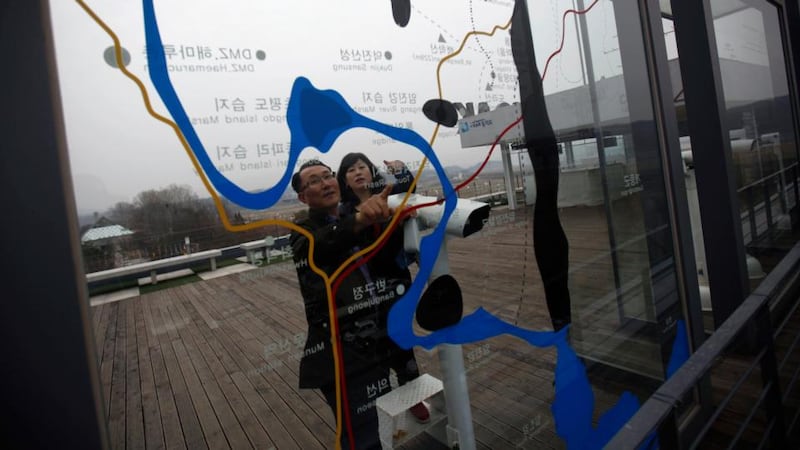A heavy machine gun points north in the direction of Pyongyang from a camouflaged bunker on the South Korean side of the demilitarised zone (DMZ), the most heavily fortified border in the world and a powerful physical and symbolic reminder of the division of Korea.
Panmunjom is where, on July 27th, 1953, the United Nations Command, the People's Liberation Army of China and the Korean People's Army of North Korea agreed to an armistice on the Korean War after protracted truce talks.
No peace treaty was ever signed, and the heavy ordnance pointed towards the North shows how the divide remains deep. On the other side, similar guns and missiles are pointed towards the South.


The DMZ is home to two million North Korean, US and South Korean troops, engaged in a relentlessly tense stand-off across the 38th parallel of the Korean Peninsula.
North Korea’s emergence as a nuclear power has added fresh tension to this lengthy stand-off.
In the last few weeks, the North's pudgy-faced young leader, Kim Jong-un, with his shaved-sided, floppy-topped hairdo, has threatened South Korea and the United States with nuclear assault, declaring a "state of war" on the Korean Peninsula.
His counterpart in the South, the newly elected president Park Geun-hye, whose father was a regular assassination target for the North, and is the democratic nation's first female leader, has told her generals to shoot back if provoked.
'Crazy talk'
"Look around you. There is no problem in South Korea. This is all crazy talk from North Korea – they are crazy," said Park Yong-ho, whose grandfather was from North Korea and taken south as a prisoner of war during the Korean War.
The craziness of the North Koreans is a recurring theme when talking to people in Seoul. English is not widely spoken, but “crazy” is clearly the default expression when describing the cousins across the border.
At the DMZ museum, a group of veterans is visiting, some of them missing arms and legs. They are joined by a company outing, whose members pay their respects to the veterans, and then all take part in a major photo session.
Remaining wound
The DMZ is proof that the Korean War remains a wound that never heals
.
"This is a social tragedy. We don't have terrorism, we don't even really have crime here in South Korea. You have to go to Iran, Iraq, these kind of places if you want terror. We have no problems here," said Mr Park.
The DMZ cuts the Korean Peninsula roughly in half, crossing the 38th parallel at an angle, with the west end lying to the south of the parallel and the east end lying north of it.
The zone is 250km long, about four kilometres wide, and looks very similar to the border areas between East and West Germany before the Berlin Wall came down.
There are checkpoints, in some ways reminiscent of the Border crossing to Northern Ireland. But the difference is that this is a border not meant to be traversed. The motorway is lined with barbed wire with camouflaged checkpoints every 500m or so, but there are no gates.
The divide is more than military – it’s economic.
Across the border, trees have been stripped of bark to feed the people in the impoverished North, where hunger is a way of life. In the car park on the southern side of the DMZ, chunky Hyundais and Kias jostle for position, and people wield an impressive armoury of digital cameras. One tourist approaches me and uses his Samsung phone to translate his comments into English.
Here is the Bridge of Freedom, built in 1953, which was used by 12,773 South Korean soldiers captured by the North, when they returned home after the armistice.
Economic ascension
At Imjingak, many visitors approach, asking where I am from, wanting to shake my hand. South Koreans are fiercely proud of the progress they have made in the years since the end of the Korean War in 1953, which have seen the country rise from one of the poorest in the world to the 15th richest.
Further back from the bunker is a steam locomotive, which used to travel all the way up to Sinuiju, which is today in North Korea, near the border with China, but it was derailed during the war.
The hulking engine made its last journey on the last day of December 1950, and it is riddled with 1,020 bullet holes, courtesy of China’s People’s Liberation Army. The Koreans refer to it as “the train that wishes to travel”.
Among the tourists lining up to be photographed beside the train are a group of mainland Chinese, who make up a large percentage of tourists visiting the site.
Wildlife sanctuary
The section between the two countries has become a kind of bird sanctuary, and birds of prey glide above it. Living among the landmines and the listening posts are rare specimens such as the red-crowned crane and the white-naped crane. There is speculation that threatened species like the Korean tiger and the Amur leopard can be found here, as can the Asiatic black bear. There are nearly 3,000 plant species.
At the joint security area at Panmunjom, Mr Park makes an offering at a shrine to his dead grandfather.
“He would love to see a unified Korea. I’m glad he came over at the end of the war, though.”













